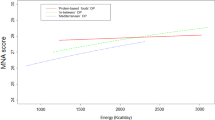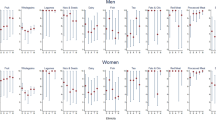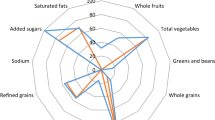Abstract
Objective:
To evaluate households’ diet-quality trends and regional disparities, as well as to identify the influence of its socioeconomic determinants.
Methods/Subjects:
Two dietary indexes were applied: a revised Healthy Diet Indicator version (HDIr) and the Mediterranean Adequacy Index (MAI). The socioeconomic differences between households with low-diet quality (if their scoring in HDIr or MAI was below the national median) and the remaining ones were analysed by means of logistic regression. Representative samples of households among each region were analysed.
Results:
Adherence to a Mediterranean diet was poor in all Portuguese regions; the proportion of households adhering to it has diminished in the North, Centre, Lisbon and Tejo valley. The proportion of households with high HDIr decreased in the North, Centre, Lisbon and Tejo valley and Algarve. In multivariate analysis, households whose head had secondary or higher education, living in semi-urban or urban areas, from the Azores region, within the higher income or outside home food expenditures groups were more likely to be in low-quality diet.
Conclusions:
The decreasing adherence to a Mediterranean food pattern and the diminishing compliance with World Health Organization dietary goals show that Portuguese households have reduced their diet quality. The observed influence of urbanization and region on diet quality highlights the importance of considering regional nutrition strategies.
This is a preview of subscription content, access via your institution
Access options
Subscribe to this journal
Receive 12 print issues and online access
$259.00 per year
only $21.58 per issue
Buy this article
- Purchase on Springer Link
- Instant access to full article PDF
Prices may be subject to local taxes which are calculated during checkout

Similar content being viewed by others
References
Alberti-Fidanza A, Fidanza F (2004). Mediterranean Adequacy Index of Italian Diets. Public Health Nutr 7, 937–941.
Alberti-Fidanza A, Fidanza F, Chiuchiu MP, Verducci G, Fruttini D (1999). Dietary studies on two rural Italian population groups of the Seven Countries Study 3. Trend of food and nutrient intake from 1960 to 1991. Eur J Clin Nutr 53, 854–860.
Assman G, Sacks F, Awad AB, Bonanome A, Booyse FM, Carmena R et al. (2000). International consensus statement: dietary fat, the Mediterranean diet, and lifelong good health. 2000 International Conference on Mediterranean Diet.(Accessed 18 December 2005: http://www.chd-taskforce.de/2000consensusstatement/index_e.htm).
Bach A, Serra-Majem L, Carrasco JL, Roman B, Ngo J, Bertomeu I et al. (2006). The use of indexes evaluating the adherence to the Mediterranean diet in epidemiological studies: a review. Public Health Nutr 9, 132–146.
CEC (1993). Nutrient and energy intakes for the European Community. Reports of the Scientific Committee for Food: 31st Series. Directorate-General Industry, Commission of the European Communities: Luxembourg.
CEC (2005). Green paper, promoting healthy diets and physical activity: a European dimension for the prevention of overweight, obesity and chronic diseases. Commission of the European Communities.
Deaton A, Paxson C (1998). Economies of scale, household size, and the demand for food. J Political Econ 106, 897–930.
EuroDiet (2001). EuroDiet core report: nutrition and diet for healthy lifestyles in Europe: science and policy implications.(Accessed: 15 July 2006) (Available at:http://ec.europa.eu/health/ph_determinants/life_style/nutrition/report01_en.pdf).
European Commission (2005). The DAFNE food classification system. Operationalisation in 16 European countries.DG-SANCO, Directorate-General for Health and Consumer Protection. Services of the European Commission: Luxembourg.
Fidanza F, Alberti-Fidanza A, Lanti M, Menotti A (2004). Mediterranean Adequacy Index: correlation with 25-year mortality from coronary heart disease in the Seven Countries Study. Nutr Metab Cardiovasc Dis 14, 254–258.
Fieldhouse P (1995). Food and Nutrition, Customs and Culture,2nd edn. Chapman & Hall: London.
Fuentes-Bol M (2002). La dieta mediterránea: su evolución.In: Serra-Majem L, Ngo J (eds). Qué es la Dieta Mediterránea? Fundación para el desarrollo de la Dieta Mediterránea. Nexus Editions: Barcelona,pp 60–73.
Garcia-Closas R, Berenguer A, González CA (2006). Changes in food supply in Mediterranean countries from 1961 to 2001. Public Health Nutr 9, 53–60.
Gracia A, Albisu LM (2001). Food consumption in the European Union: main determinants and country differences. Agribusiness 17, 469–488.
Holland B, Welch AA, Unwin ID, Buss DH, Paul AA, Southgate DAT (1991). McCance and Widdowson's The Composition of Foods,5th edn, Royal Society of Chemistry: Cambridge.
Huijbregts P, Feskens E, Rasanen L, Fidanza F, Nissinem A, Menotti A et al. (1997). Dietary pattern and 20 year mortality in elderly men in Finland, Italy, and the Netherlands: longitudinal cohort study. BMJ 315, 13–17.
INE (1990). Inquérito aos orçamentos familiares 1989/90. Metodologia. Instituto Nacional de Estatística: Portugal.
INE (1997). Inquérito aos orçamentos familiares 1994/95. Metodologia. Instituto Nacional de Estatística: Portugal.
INE (1999). Balança alimentar Portuguesa 1990/97. Instituto Nacional de Estatística: Portugal.
INE (2002). Inquérito aos orçamentos familiares 2000. Instituto Nacional de Estatística: Portugal.
Kant A (1996). Indexes of overall diet quality: a review. J Am Diet Assoc 96, 785–791.
Kant A (2004). Dietary patterns and health outcomes. J Am Diet Assoc 104, 615–635.
Knoops KTB, Groot de LC, Fidanza F, Alberti-Fidanza A, Kromhout D, Van Staveren WA (2006). Comparison of three different dietary scores in relation to 10-year mortality in elderly European subjects: the Hale project. Eur J Clin Nutr 60, 746–755.
Lagiou P, Trichopoulou A, DAFNE contributors (2001). DAta Food Networking. The DAFNE initiative: the methodology for assessing dietary patterns across Europe using household budget survey data. Public Health Nutr 4, 1135–1141.
Lagiou P, Trichopoulou A, Henderickx HK, Kelleher C, Leonhauser IU, Moreiras O et al. (1999). Household budget survey nutritional data in relation to mortality from coronary heart disease, colorectal cancer and female breast cancer in European countries. DAta Food Networking. Eur J Clin Nutr 53, 328–332.
Marques-Vidal P, Dias CM (2005). Trends and determinants of alcohol consumption in Portugal: results from the National Health Surveys 1995 to 1996 and 1998 to 1999. Alcohol Clin Exp Res 29, 89–97.
Marques-Vidal P, Ravasco P, Dias CM, Camilo ME (2006). Trends of food intake in Portugal, 1987–1999: results from the National Health Surveys. Eur J Clin Nutr 60, 1414–1422.
Mennel S, Murcott A, Otterloo AH (1992). The Sociology of Food, Eating, Diet and Culture. SAGE Publications, London.
Moreira P, Padrão P (2004). Educational and economic determinants of food intake in Portuguese adults: a cross-sectional survey. BMC Public Health 4.
Naska A, Fouskakis D, Oikonomou E, de Almeida MDV, Berg MA, Gedrich K et al. (2006). Dietary patterns and their socio-demographic determinants in 10 European countries: data from the DAFNE databank. Eur J Clin Nutr 60, 181–190.
Nestle M (1995). Mediterranean Diets—historical and research overview. Am J Clin Nutr 61, 1313S–1320S.
Popkin B (2006). Global nutrition dynamics: the world is shifting rapidly toward a diet linked with noncommunicable diseases. Am J Clin Nutr 84, 289–298.
Ribeiro O (1998). Portugal, o Mediterrâneo e o Atlântico.(7a Edição) Lisboa, Livraria Sá da Costa Editora.
Ricciuto L, Tarasuk V, Yatchew A (2006). Socio-demographic influences on food purchasing among Canadian households. Eur J Clin Nutr 60, 778–790.
Robertson A, Tirado C, Lobstein T, Jermini M, Knai C, Jensen JH et al. (2004). Food and Health in Europe: A New Basis for Action. WHO Regional Publications: Copenhagen,European Series no 96.
Rodrigues SSP, de Almeida MDV (2001). Portuguese household food availability in 1990 and 1995. Public Health Nutr 4, 1167–1171.
Rodrigues SSP, Lopes C, Naska A, Trichopoulou A, de Almeida MDV (2007). Comparison of national food supply, household food availability and individual food consumption data in Portugal. J Public Health,First online publication (DOI 10.1007/s10389-007-0102-8).
Roos G, Prattala R (1999). Disparities in Food Habits, Review of Research in 15 European Countries (Disparities part of the FAIR-97-3096 project).Publications of the National Public Health Institute: Helsinki.
Serra-Majem L, Ferro-Luzzi A, Bellizzi M, Salleras L (1997). Nutrition policies in Mediterranean Europe. Nutr Rev 55, S42–S57.
Serra-Majem L, Roman B, Estruch R (2006). Scientific evidence of interventions using the Mediterranean diet: a systematic review. Nutr Rev 64 (2 Part 2), S27–S47.
Trichopoulos D, Lagiou P (2004). Mediterranean diet and overall mortality differences in the European Union. Public Health Nutr 7, 949–951.
Trichopoulou A (2001). Mediterranean diet: the past and the present. Nutr Metab Cardiovasc Dis 11, 1–4.
Trichopoulou A, Kouris-Blazos A, Wahlqvist ML, Gnardellis C, Lagiou P, Polychronopoulos E et al. (1995). Diet and overall survival in elderly people. BMJ 311, 1457–1460.
Trichopoulou A, Naska A, Costacou T, DAFNE III Group (2002). Disparities in food habits across Europe. Proc Nutr Soc 61, 553–558.
Trichopoulou A, Orfanos P, Norat T, Bueno-de-Mesquita B, Ooke MC, Peeters PH et al. (2005). Modified Mediterranean diet and survival: the EPIC-elderly prospective cohort study. BMJ 330, 991–997.
WHA (2004). Global strategy on diet, physical activity and health.Fifty-seventh World Health Assembly, 57.17, 22 May.
WHO (1990). Diet, Nutrition, and the Prevention of Chronic Diseases,Report of a Study Group. Technical Report Series No. 797. World Health Organization: Geneva.
WHO/FAO (2003). Diet, Nutrition and the Prevention of Chronic Diseases: Report of a Joint WHO/FAO Expert Consultation.WHO Technical Report Series, Technical Report 916. WHO: Geneva; FAO: Rome.
Willett W (2006). The Mediterranean diet: science and practice. Public Health Nutr 9, 105–110.
Willett WC, Sacks F, Trichopoulou A, Drescher G, Ferro-Luzzi A, Helsing E et al. (1995). Mediterranean diet pyramid: a cultural model for healthy eating. Am J Clin Nutr 61, 1402S–1406S.
Acknowledgements
This study was conducted in the context of the DAFNE IV project entitled ‘European food availability databank based on household budget surveys’ of the DG-SANCO of the European Commission. We thank the Instituto Nacional de Estatística, the Portuguese institution responsible for the Household Budget Surveys, for allowing us the use of its databases. The first author is a PhD student with a scholarship sponsored by PRODEP III, European Commission.
Author information
Authors and Affiliations
Corresponding author
Rights and permissions
About this article
Cite this article
Rodrigues, S., Caraher, M., Trichopoulou, A. et al. Portuguese households’ diet quality (adherence to Mediterranean food pattern and compliance with WHO population dietary goals): trends, regional disparities and socioeconomic determinants. Eur J Clin Nutr 62, 1263–1272 (2008). https://doi.org/10.1038/sj.ejcn.1602852
Received:
Revised:
Accepted:
Published:
Issue Date:
DOI: https://doi.org/10.1038/sj.ejcn.1602852
Keywords
This article is cited by
-
Worldwide adherence to Mediterranean Diet between 1960 and 2011
European Journal of Clinical Nutrition (2019)
-
Is nutritional quality of food-at-home purchases improving? 1969–2010: 40 years of household consumption surveys in France
European Journal of Clinical Nutrition (2018)
-
The prevalence of the metabolic syndrome in Portugal: the PORMETS study
BMC Public Health (2017)
-
Adherence to a Mediterranean-like dietary pattern in children from eight European countries. The IDEFICS study
International Journal of Obesity (2014)
-
Effect of sociodemographic variables and time on food group contribution to total food availability in Portuguese elderly households
The Journal of nutrition, health and aging (2014)



